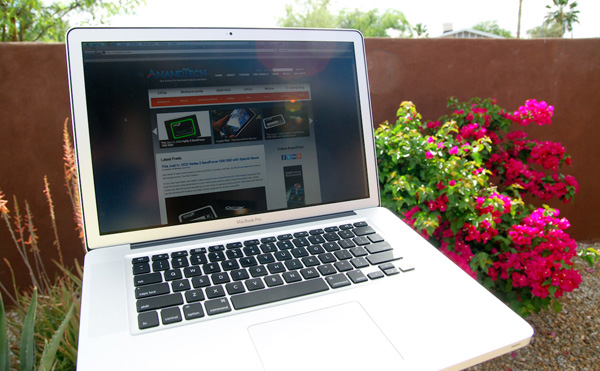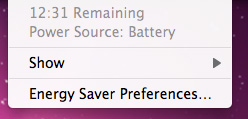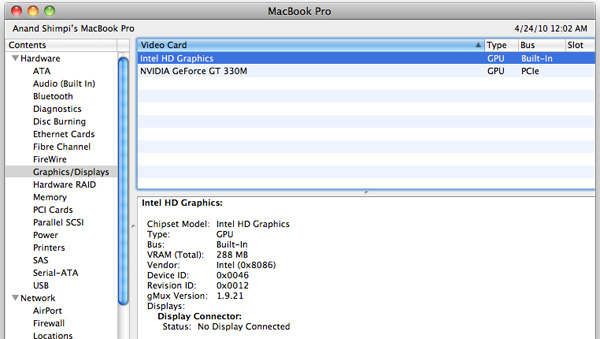Apple's 15-inch 2010 MacBook Pro: More Battery Life Tests, High Res Display Evaluated
by Anand Lal Shimpi on April 24, 2010 1:57 AM EST- Posted in
- Mac
- Displays
- MacBook Pro
- Arrandale
- Laptops
Apple is in a position that’s enviable by any consumer facing company. It drums up genuine excitement for nearly every product it launches. Apple has somehow found a way to make something as small as just another processor refresh exciting.
It’s not all smoke and mirrors though. The previous generation unibody MacBook Pro posted some incredible battery life numbers. And two weeks ago Apple paired it with Intel’s Core i5 and i7 mobile CPUs, delivering the sort of desktop-like performance we’ve been waiting for.

Since the release we’ve had the time to answer a few more questions about the new systems. We updated our launch article with Core i5 vs. Core i7 results. But today, in response to many of your requests, we’ve got more battery life results and a full evaluation of the 15-inch MacBook Pro’s display quality. Apple is often the go-to manufacturer for creative professionals, we put our colorimeter on the MacBook Pro to find out if they’re making the right choice.
Battery Life: Better and Worse in the Real World
Battery life on the new MacBook Pro is a lot more varied than it was on the old one. While our light web browsing test does a good job of showing you what very light usage can give you, I find that the new 15-inch MacBook Pro spends more time at states of higher power draw than the old one. This is difficult to show as a single benchmark result but it appears to be because of two things.

The obvious cause is that the Core i5/i7 CPUs let you do more with the machine. Tasks complete quicker, the system is more responsive and as a result you end up doing more with the machine.
The second part of the problem is Apple’s automatic graphics switching technology. While it relies on applications that use specific frameworks (e.g. OpenGL, OpenCL, Quartz Composer, Core Animation and Core Graphics), many have pointed out strange behavior when doing something as harmless as browsing the web.
An attentive Mac Rumors reader pointed out that by looking at OS X’s System Profiler you can find out what GPU is being used: the active GPU will list the specs of the display it’s driving:

The inactive GPU will simply state that there’s “No Display Connected”. Start up Photoshop and you’ll see the discrete GPU kick in, close it and you’ll see Intel’s HD Graphics take over.

Readers of my first Month with a Mac article will know that one thing I quickly embraced about OS X was the idea of just leaving applications open. If you’ve got enough memory, OS X tends to do just fine with a ton of applications open. In fact, the UI is designed around it; closing all application windows rarely quits the app itself, Apple appears to want you to leave your frequently used apps open and idle. It makes switching between them that much faster. The fact that the new MacBook Pro’s discrete GPU won’t power down if you have an application like Photoshop open flies in the face of this leave-your-apps-open usage model.
So you’ve got to be mindful of what applications will trigger the discrete GPU to take over. That’s not terribly hard, but there’s just one problem: sometimes your web browser can wake up the dGPU. I’ve found numerous cases where Google Chrome will activate the discrete GPU, while our own Brian Klug found that Firefox did the same. I haven’t extensively tested Safari to see if it has the same issue. I suspect this is a software bug, but it is one that lowers battery life in real world usage scenarios. The discrete GPU remains powered down in all of my OS X battery life tests, but I found that in my using the new MacBook Pro my battery ran down much quicker than I was expecting. Part of it is the potentially more power hungry Arrandale CPU, but part of it is the fact that the discrete GPU was active when it had no reason to be.
You’ll still get better battery life compared to an older MacBook Pro, and you have the potential to get better battery life than last year’s 2nd gen unibody MacBook Pro. But as I mentioned in our review, there’s also the chance that you’ll see lower battery life than the previous model. And as I’ve come to realize, that chance is higher than I originally thought because of the issues mentioned above. It's even higher if you opt for the Core i7 model...










69 Comments
View All Comments
Penti - Sunday, April 25, 2010 - link
There is still no IPS-panels for notebooks being produced really even though the battery powered iPad got one in a area where there were none, but on the other hand as they try to sell it as a machine that can do anything they need a wide-angle viewing screen. Otherwise people would just laugh at it as a ebook-reader and cool colors and comics won't change that. People have grown used to sitting straight in front of the laptop screen. It just isn't acceptable in a tablet device, and smart phones has even begun using AMOLED screens. In fact the professional tablets (i.e. those costing 1500+ dollars) have been using IPS based screens for a while now. But I don't think a single screen is manufactured for 15" notebooks with IPS, and the screens for the 12-13" convertible tablets are optimized for power consumption and viewing angles any way not color. I don't see Apple pony up for IPS-panels in the macbooks. They will get them when the others do use them. Custom parts just aren't apart of their computer lineup. We can't expect more then the Geforce 320M chipset in that apartment :)rcocchiararo - Sunday, April 25, 2010 - link
Are there diferent "grades" in TN panels quality ?im 100% sure my GF notebook has worse viewing angles than my late 2008 macbook pro, and that my 2007 or so macbook white was similar or worse than my gf notebook.
Also, no notebook from work has a decent display either.
I almost thought that my macbook pro had a "mobile version" of the s-ips panel my 20.1 inches dell from 2007 has :P
rpottol - Tuesday, April 27, 2010 - link
Yup, Levanto dropped them from Thinkpads because the just could not get them reliably in the quantities they needed.Sigh.
I think I will stick with older thinkpads, but then I'm the sort of person who would want a 15" QXGA display (2048x1536) and yet not have the CPU for HD playback (well, perhaps).
Xyp - Monday, April 26, 2010 - link
Anand -There is lots of interest in seeing some of your benchmark numbers on the current-gen MBPs (128, 256, and 512...), especially after degradation. If any of your people know the skinny on whether Apple has at all revised the firmware on the currently-shipping Toshiba drives, or whether they will be attempting a TRIM-like function (let's be serious, it's Apple... they'll rename it) with updates to OSX, that information would also be much appreciated.
Thanks for your excellent site.
Wolfpup - Monday, April 26, 2010 - link
Does this let you install the normal Nvidia reference drivers under Windows? People seem to think Apple's preventing it (or possibly it won't work because of their switching technology).Either way, if this won't run normal drivers, that rules it out for me :(
asiafish - Monday, April 26, 2010 - link
I just got the new 15" i7 with high-res matte display, and must say this is by far the fastest computer I have ever owned. Build-quality is every bit as good as my Oct 08 MacBook Air, and far better than any pre-unibody Mac (or any other laptop) I've ever used.Battery life is incredible with simple browsing in Safari and email/calendar in Entourage.
gochichi - Tuesday, April 27, 2010 - link
For example, does the glossy high resolution screen offer up the same backlight? How do you know that the $50 cheaper glossy display will have the 400 nits backlight? Is the 1440x900 screen as bright?I mean guys, what I'm hoping a tech website can do for me just to put it bluntly is help me make a decision as to which product to use or buy. In a nutshell, help me make an informed decision. What I want to see is a 3-way comparison of the standard glass covered display, the glossy high res display and the matte high res display. What I get instead is an opinion that someone else would go with a glossy high res display that they've in fact never even seen.
Measure stuff for me, show me some pictures of things I want to see. I've been a long term reader of Anandtech and frankly I expect the obvious. Worse yet, I can go to a local Apple shop and compare th low res to the matte display for myself.
Honestly... on what grounds are you recommending the glossy high res. It just "sounds cool"? Sigh.
Brian Klug - Friday, May 14, 2010 - link
I think you're reading a different article entirely, because basically everything you just sounded off on is actually in this one:1. 400 nits claim - Right inside: http://www.anandtech.com/show/3669/apples-15inch-2...
Performance was 412 measured with an i1D2.
2. Matte > Glossy - Also inside: http://www.anandtech.com/show/3669/apples-15inch-2...
Comparison and side-by-side with photos.
I'm confused what you're reading, because *all* of that stuff is there.
-Brian
jlyall - Saturday, May 1, 2010 - link
Hi Anand,A big cheers for both the write ups on the new MBP. You have made my job of choosing about 1000x times easier. The hole in my pocket will be bigger but I know I will be happier in the long run. Cheers again and have a lovely day.
warmest regards,
J
Woodoo - Tuesday, May 4, 2010 - link
Hi there, I have a question regarding viewing angles differences between the glossy and matte options. Is there a noticable (or at least some) difference between the two LCD panels mounted to the latest MacBook Pros in this aspect?P.S.: I'd love to see an IPS panel in the future MacBooks Pro, even as a high price option...